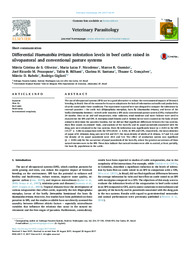Differential Haematobia irritans infestation levels in beef cattle raised in silvopastoral and conventional pasture systems.
Differential Haematobia irritans infestation levels in beef cattle raised in silvopastoral and conventional pasture systems.
Author(s): OLIVEIRA, M. C. de S.; NICODEMO, M. L. F.; GUSMAO, M. R.; PEZZOPANE, J. R. M.; BILHASSI, T. B.; SANTANA, C. H.; GONÇALVES, T. C.; RABELO, M. D.; GIGLIOTI, R.
Summary: The use of silvopastoral systems (SPS) can be a good alternative to reduce the environmental impacts of livestock breeding in Brazil. One of the reasons for its scarce adoption is the lack of information on health and productivity of cattle raised under these conditions. The experiment reported here was designed to compare the infestation by external parasites ? the cattle tick (Rhipicephalus microplus), horn fly (Haematobia irritans), and larvae of the botfly (Dermatobia hominis) ? in beef cattle raised in a SPS and a conventional pasture system (CPS), evaluated for 24 months. Data on air and soil temperature, solar radiation, wind incidence and water balance were used to characterize the SPS and CPS. R. microplus adult females and D. hominis larvae were counted on the body of each animal to determine the parasites burdens, but we did not find significant differences between the two systems. Horn flies counts on animals? body, and analysis of the horn fly and its pupal parasitoids associated with the dung pats were obtained in the two systems. Horn fly infestation was significantly lower (p = 0.01) in the SPS (13.17 ± 3.46) in comparison with the CPS (24.02 ± 4.43). In SPS and CPS, respectively, the mean densities of pupae of H. irritansin dung pats were 9.8 and 10.7; the mean density of adults of H. irritans, 3.7 and 3.5; and the density of its pupal parasitoids were 20.5 and 5.4. The effect of production system was significant (p < 0.05) only for the occurrence of pupal parasitoids of the horn fly, where the greatest occurrences of these natural enemies were in the SPS. These data indicate that natural enemies were able to control, at least partially, the horn fly populations in the cattle.
Publication year: 2017
Types of publication: Journal article
Keywords: Environmental complexity, Horn fly, ILPF, beef cattle, biodiversity
Observation
Some of Embrapa's publications are published as ePub files. To read them, use or download one of the following free software options to your computer or mobile device. Android: Google Play Books; IOS: iBooks; Windows and Linux: Calibre.
Access other publications
Access the Agricultural Research Database (BDPA) to consult Embrapa's full library collection and records.
Visit Embrapa Bookstore to purchase books and other publications sold by Embrapa.

